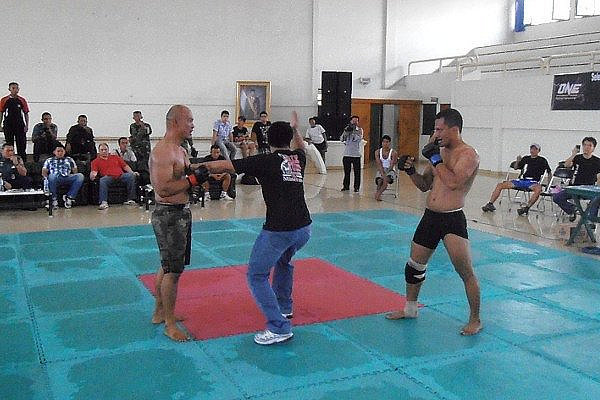One FC's Opportunity in the Archipelago

Could success for One FC help Indonesia's MMA scene out of the
cellar? | Photo: Tomasz Marciniak
Mixed martial arts fans across the world like to quickly identify Asia -- more specifically, Southeast Asia -- as a potential hotbed for this developing sport. It is not difficult to see why.
Thailand’s muay Thai remains one of the crucial striking styles in MMA and it is just one of the numerous traditional martial arts in the region. After all, UFC was one decision away from holding an event in the Philippines a couple of years ago.
Advertisement
MMA was introduced to the country near the turn of the millennium thanks to local television stations airing reruns of old UFCs, as well as broadcasting more recent Pride events. This was enough to get the ball rolling and get TV watchers training, trying to mimic what they were seeing. Shortly after that, TPI Fighting Championship, the first Indonesian MMA promotion, came into existence.
TPI, or Televisi Pendidikan Indonesia, was originally
conceived as a national educational broadcaster for its 1991
launch. Renamed MNCTV in 2010, the network has since become an
important hub for sports, soap operas and reality TV.
“The marketing director of the national television station TPI was a fan of Pride FC, so he created shows with the same rules and judging criteria as Pride,” explains Niko Han, owner of Synergy Jiu-Jitsu, who operates schools across the archipelago and is the country’s sole BJJ black belt. Han was asked to be one of the judges for TPI.
However, this being Indonesia, it did not take long for backstage politics to come into play.
Jesse Ariestya was also involved in the TPI project and is now an official with the Indonesian Martial Arts Federation (FOBI). Ariestya says that allegations of bribery within the TPI FC promotion began to hurt the company's image and resultantly, the Indonesian government and the Indonesian Olympic Committee got involved. The sanctioning bodies threatened to ban the participants from their respective Olympic or Southeast Asian Games bids if they were involved with the organization.
Ariestya teamed up with retired tae kwon do fighter Lam Ting and judo player Perry Pantouw. To placate the Indonesian Olympic Commitee, they went to a different TV station, RCTI. With the patronage of RCTI, they started Duel, another MMA promotion differing from TPI FC by their use of a cage and rules which favored strikers to please the Indonesian crowd.
With two different events running simultaneously on national TV from 2002 to 2005, Indonesian MMA experienced what might be called a “golden age,” especially compared to the barren reality of 2012. Unfortunately, it was not to last.
Duel went down first and in dramatic fashion.
“I remember sitting with Lam Ting in the booth,” says Ariestya, who was doing commentary for the event. “Suddenly, out of the corner of my eye, I see this huge sword in the stands.”
Details of the ensuing riot are sketchy, but those who remember invariably recall the sword. Though the particulars are hazy, the damage was definitive enough for RCTI to immediately pull the plug on the promotion. TPI FC continued on, but would soon meet its own demise.
“The program director for TPI, who was supportive of MMA, got ousted and replaced by this woman who was opposed to the sport,” says Fransino Tirta, Indonesia’s top fighter, who made his name on TPI shows. “The popularity of the show wasn’t so big, so the station decided to cut the budget and devote it to a local take of ‘American Idol.’”

T.
Marciniak
Fransino Tirta is Indonesia's
finest MMA fighter.
“Both nationally televised MMA shows, TPI FC and Duel, were producing shows every week, but the quality of the fights were poor, so TV ratings went down and all the sponsors ended up pulling out,” he opines.
By 2005, Indonesia was without a legitimate MMA promotion. It was up to individual gyms, such as Han’s Synergy Jiu-Jitsu, to carry Indonesian MMA through this period.
“In 2005, I started organizing competitions throughout Indonesia in order to aggressively socialize and popularize the sports of MMA and BJJ,” Han recalls.
Other gyms followed suit. Tirta’s newly opened Syena Martial Arts Center in Jakarta organized three in-house events for its fighters in 2011. However, information about these shows rarely reaches beyond the local community and instead is usually restricted to
members of the gyms participating in the event.
“The problem with the Indonesian fight scene is that it’s not united,” Tirta identifies. “Boxers train with boxers, wrestlers train with wrestlers and do not seek out to improve in other disciples.”
Ariestya kept pitching the idea of an MMA show to various networks. In 2007, it appeared they were on the verge of breakthrough, having already taped a pilot episode. However, in another stroke of bad luck, a young Indonesian pro-wrestling fan died while re-enacting wrestling maneuvers with his friend. Despite the differences between MMA and WWE, the Indonesian media didn’t see much of a distinction in their reporting. TV producers backed away from any MMA programming, fearing bad PR after the tragic accident.
In this climate, MMA was heading the way of the Sumatran rhino.
“Indonesian MMA simply died out, with Bali as the last place of reported sightings. Only a handful of active professional MMA fighters remain,” says Jarot Dasaputranto of MMAddict-Indonesia.com, one of the very few people covering local MMA in a journalistic capacity.
Tirta also doesn’t mince his words.
“MMA is pretty much dead,” he states bluntly. Tirta has been an MMA instructor for four years now and never has his class exceeded 20 people; the average number remains around 10.
“Sport officials don’t acknowledge MMA as a valid sport. Most of them still see it a violent cockfighting,” Dasaputranto explains. “The other factor is the lack of recognizable figures competing in MMA.”
Dasaputranto cites a TPI-broadcast program about MMA presented by well-known actor and martial artist Dede Yusuf in the early 2000s as an example of the kind of promotion that served MMA well in the past in Indonesia.
Considering this climate, Singapore-based One Fighting Championship’s decision to come to Jakarta for only its second show seems quite audacious. However, the promotion’s CEO, Victor Cui, is not concerned by the local problems that MMA has faced.
“Jakarta has some of the most passionate fight fans and sport fans in Asia, and you can go to any sporting event and see how fanatical they are about sports,” Cui says.

T.
Marciniak
Major success for One FC 2 could
be instrumental in Indonesia.
“Hopefully, One FC can be the beginning of resurrection for Indonesian MMA and will make it easier to garner support from the government,” says Youne Victorio Senduk, a 2011 Southeast Asia Games silver medalist in sanshou, who is being positioned as the main Indonesian star on the One FC card.
MNCTV has recently started airing old Duel events, as well. Ariestya points to this fact as proof of MMA’s changing fortunes, noting that MNCTV is part of the same media conglomerate supporting One FC in Indonesia.
“I’m positive that Indonesians are more ready for the sport now,” Ariestya says. “The people are more mature and knowledge of MMA is more common.”
“In 2005, the sport was only popular amongst the local fighters because we had televised shows that paid them to fight,” adds Han. “The mainstream audience was not into it as they are now.”
Up until about three months ago, UFC events aired on one of the cable channels in the country, further exposing people to the sport. The UFC’s move to Fox stateside meant that the promotion went into the dark in Indonesia for a moment. However, it is set to return, with Fox Movies Premium already running ads about the UFC “coming soon” to its airwaves.
“I’ve seen the MMA situation in Thailand, Singapore and the Philippines,” Tirta says, “and I don’t think we’re that far from them.”
Related Articles






